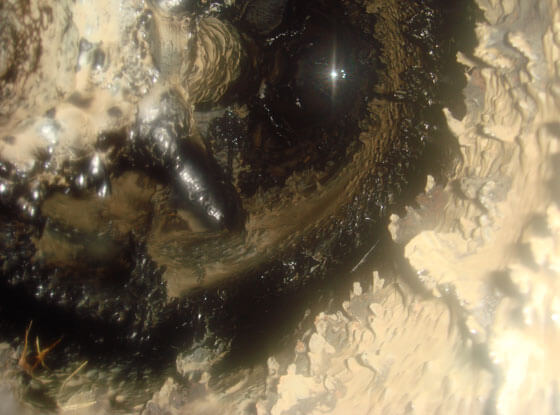While fermenters and evaporators get priority, don’t forget to consider pipes and pumps and ductwork.
Certain areas of ethanol facilities get a lot of attention from the management team when monitoring plant operations—fermenters and evaporators quickly come to mind, but other areas should not be neglected.
Some cleaning tasks are ongoing. On the top of the list for avoiding yield-robbing bacterial infections is the proper cleaning of fermenters after each batch is dropped. Maintaining optimal clean-in-place (CIP) operations is important to flush away any residual mash where bacteria could get a foothold. While ethanol plants are far from sterile environments, it is critical that bacteria levels be kept as low as possible.

The intense fouling in the pictured process line is not commonly seen, but can happen if a line is neglected.
Avoiding yield-robbing bacterial infections
Evaporators are typically on a regular cleaning schedule as well. The thin stillage separated by the centrifuges is high in suspended and dissolved solids that easily build up in the evaporators used to condense the liquids into syrup. Plants are designed with extra evaporators so one can be taken off line for cleaning while the plant continues running the process stream through the other evaporators. But even when cleaning one or two evaporators a week, over time the caustic solution used for CIP can’t keep up. When that happens, the evaporators begin pressuring up and distillation slows down, causing a reduction in plant throughput capacity. Most plants schedule shutdowns in the spring and fall for maintenance and inspections and thorough hydroblasting of the evaporators to bring operations back in line.
Heat exchangers are also critical components of the system that can become fouled or plugged, increasing pressure that wears on pumps, reducing process stream flow and ultimately decreasing exchanger efficiency that could lead to an increase in energy cost.
While evaporators and heat exchangers get a lot of attention during shutdowns, plants should take advantage of the opportunity to inspect and clean areas inaccessible while the plant is running. Cleaning ductwork in the area where distillers grains is dried and emissions are controlled in the oxidizer is particularly important. Removing any build up of material in ducts that could contribute to a fire or explosion hazard is an important safety measure, reducing risk to property damage and even personal injury.

The operation team’s pride is visible at this plant that is clean as a whistle, even after 14 years of 24/7 operations.

An example of an area shows how few access points can be available for inspection and cleaning of process lines.
In supporting ethanol facilities on general maintenance, the team in After Market Services at ICM Inc. often see other areas getting overlooked at many plants. As corn is ground and mixed with water, pumps and piping direct the process stream throughout the plant. Buildup of material anywhere in the plant—and not just in the evaporators or around the dryers—can cause issues.
The piping that moves process streams throughout the plant needs attention as well. The same solids build-up that plague evaporators can become an issue in piping. The lines near the evaporators do get cleaned in the CIP cycle, but often there are 50 to 75 yards between the evaporators and the syrup tank. Another 25 yards of piping directs the syrup from the tank to the feed conveyer where the syrup is spread onto the wet cake heading to the dryer. That’s a lot of piping where syrup solids can create issues.
Proper cleaning ultimately improved operations in the dryer area of the plants
The centrate system is often overlooked as well. Centrate fans pull vapor from multiple process tanks in the heart of the plant. The vapor is passed along through piping to the energy center, generally located at one end of the plant, where volatile organic com-pounds are destroyed in an oxidizer to maintain emission compliance. While it may seem like simple vapor, one can be surprised by the amount of particulate solids that settle out in different spots in the many yards of pipe strung throughout the plant.
While there are access points at tank originations and line endings, plants are beginning to add access in other areas to aid in cleaning. Plant operators realized the dryer burner chambers lacked good access to properly clean them and ICM After Market Services has provided better access to the dryer burner chambers and ducting. Besides mitigating a safety hazard, proper cleaning ultimately improved operations in the dryer area of the plants.
Keeping plants running smoothly with minimal downtime is the goal for any maintenance and repair program. But that’s not the only reason. We’ve all been in a plant and said, “Wow, this facility looks fantastic.” However, we’ve also seen the opposite scenario, and wondered how anyone would want to work in such conditions. Keeping everything from the floors cleaned to the outer appearance of equipment in top shape provides an environment that encourages the entire team to take pride in the workplace, and ultimately leads to improved productivity, health and safety.
